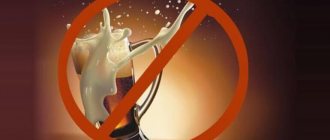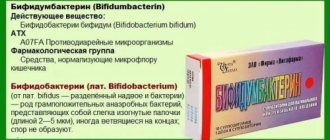Instructions
Probiotics are often recommended to be taken during antibiotic therapy. They help normalize intestinal microflora and stimulate the body's defenses. This category of products includes Bifiform or Bifidumbacterin.
Bifiform and Bifidumbacterin help normalize the intestinal microflora and stimulate the body's defenses.
Compound
The active components of Bifiform are lactic acid bacteria that affect the activity of the gastrointestinal tract:
- Bifidobacterium longum
- Enterococcus faecium
The manufacturer uses the following as excipients:
- lactulose
- gum
- magnesium stearate
- lactic acid starter
- anhydrous dextrose
How they affect the body
Bifiform contains 2 types of lactic acid bacteria - Bifidobacterium longum and Enterococcus. This type of bacterial agent lives on the mucous membrane of the digestive organs.
There are also additional substances in the form of magnesium stearate, lactulose, yeast extract and dextrose. Live bacteria are placed in a small capsule. After consuming it, they penetrate the intestines and colonize it, while displacing harmful microbes. The active ingredients do not penetrate into the general bloodstream, but act only locally.
Bifidumbacterin contains bifidobacteria, bifidogenic factor and lactose. Thanks to this combination, redox reactions are accelerated, the growth of pathogenic flora is suppressed against the background of lactic acid synthesis, immune defense is increased, and the digestive process is improved. Bifidumbacterin is considered an indispensable remedy for hypertrophy or anemia in a child. After taking the medicine, accelerated synthesis of amino acids and B vitamins is observed.
Bifidumbacterin is considered an indispensable remedy for hypertrophy or anemia in a child.
Pharmacodynamics and pharmacokinetics
The action of the pharmaceutical drug is explained by the components of the drug, which are able to maintain and normalize the physiological balance of the intestinal flora. The active components of the drug colonize the small and large intestines. By producing lactic and acetic acids, active bacteria suppress the development and reproduction of pathogenic microorganisms.
Bifiform promotes:
- improving the functioning of the gastrointestinal tract
- increase in nonspecific resistance of the body
- stabilization of intestinal microbiocenosis
Pharmacology and pharmacodynamics
As already mentioned, the drug is intended to stabilize the intestinal flora. The constituent components help maintain normal intestinal microflora. Beneficial bacteria themselves are present in the body, but as a result of negative effects their balance can be disrupted. It is for this purpose that the medicine is prescribed. Active bacteria coming from the drug do not allow harmful bacteria to spread. The result is a positive effect on the digestive system.
Instructions for use Bifiform
The annotation describes in detail how to take the drug. Children over 2 years of age and adult patients are recommended to take 2-3 capsules per day. In case of urgent need, the dosage can be increased to 4 capsules.
In the first days of therapy, the patient may feel the antidiarrheal effect of the drug. For acute diarrhea, the treatment course should last from 2 to 3 days.
In some cases, the doctor may prescribe medication for 3 weeks. The medicine can also be taken in combination with other medications (suppositories with Indomethacin).
Bifiform can be taken both before and after meals.
Many patients turn to doctors asking whether it is possible to combine Bifiform with antibiotics. Experts have one answer - it is better to avoid such a combination, because bifidobacteria will be utilized. It is better to start using Bifiform after antibiotic therapy.
The smartest thing to do would be to ask your doctor how much and in what quantity you should take Bifiform.
Bifiform
Bifiform ®
(lat.
Bifiform
® ) is a medicine that normalizes intestinal microflora, a probiotic.
Available in the form of enteric-coated capsules. Active components:
- Bifidobacterium longum ,
one capsule contains at least 10,000,000 bacterial cells - Enterococcus faecium ,
one capsule contains at least 10,000,000 bacterial cells
Excipients:
anhydrous dextrose (glucose), lactulose, lactic acid starter, gum, magnesium stearate.
Capsule shell substances:
copolymer of methacrylic acid and methyl methacrylate (MAA-MAS), copolymer of methacrylic acid and ethacrylate (MAA-EAC 30%), talc, macrogol 6000, titanium dioxide, soybean oil, magnesium stearate, acetylated glycerides.
Bifiform is intended for the treatment and prevention of dysbacteriosis of various etiologies. The lactic acid bacteria included in the drug maintain and regulate the physiological balance of intestinal microflora. The acid-resistant capsule protects the bacteria contained in the drug from destruction under the influence of gastric acid. When it enters the intestines, where the acidity of the environment is 6.0 - 6.8 pH, the capsule dissolves. Bacteria actively colonize the small and large intestines. They produce acetic and lactic acids, thereby inhibiting the growth and reproduction of pathogenic microbes. Bifidobacteria and non-toxigenic lactic acid enterococci Enterococcus faecium
also participate in the synthesis and absorption of vitamins, carry out the enzymatic breakdown of proteins, fats and complex carbohydrates (including lactase deficiency in children). Bifiform contributes to a significant reduction in opportunistic microflora (staphylococcus, Proteus, hemolytic Escherichia coli, Klebsiella, etc.).
Bifidobacterium longum
- an anaerobic gram-positive bacterium that colonizes predominantly the large intestine, being its main parietal and luminal microflora.
In healthy newborns who are breastfed, Bifidobacterium longum
colonizes the intestines from 5 to 20 days after birth.
In young children, Bifidobacterium longum
makes up the majority of all intestinal microorganisms. The strain used in bifiform is ATCC 15707.
Enterococcus faecium
(old name
Streptococcus faecium
) is an aerobic gram-positive bacterium, lactic acid enterococcus, which colonizes primarily the small intestine. Bifiform uses a specially selected non-toxigenic strain of Enterococcus faecium SF68, which is characterized by a high level of antibiotic resistance and non-pathogenicity.
In the genome of the Enterococcus faecium
SF68 lacks the virulence genes known for pathogenic clinical isolates of enterococci: gelE (
gelatinize
), sprE (
serine protease
), esp (
extracellular surface protein
), fsrB (
virulence factor regulator
), asa1 (
aggregation substance
).
Enterococcus faecium
SF68 is sensitive to vancomycin, ampicillin, piperacillin, chloramphenicol, erythromycin, imipenem, ciprofloxacin and fusidic acid and resistant to methicillin, cefuroxine, aztreonam, mipramine, tobramycin, streptomycin (Bondarenko V.M. Multicomponent probiotics : therapeutic effect for intestinal dysbiosis and mechanism of action).
Taking B. longum
and
E. faecium
results in transient colonization of the intestine (increase in abundance) by these bacteria for a period of approximately 7 days. These bacteria, despite numerous beneficial effects, as well as all other probiotic strains included in drugs and dietary supplements, are not equivalent to their own indigenous microflora and are not able to multiply in the intestines. One reason for this may be bioincompatibility with resident human bacteria. Even the most effective probiotics only act during the course of treatment and are found in feces no longer than one to two weeks after the end of treatment.
Indications for use:
- normalization of intestinal microflora
- prevention and treatment of gastrointestinal disorders
- maintaining immunity in children over 2 years of age and adults
Helicobacter pylori
eradication therapy , due to the possibility of side effects associated with the development of dysbiotic changes in the intestine, the inclusion of probiotics in the treatment regimen is recommended. The drugs of choice are complex probiotic agents, such as Bifiform and Linex (Khavkin A.I., Zhikhareva N.S., Rachkova N.S.).
Professional medical publications,
concerning the use of bifiform in the treatment of the gastrointestinal tract:
- Khavkin A.I., Zhikhareva N.S., Rachkova N.S. Modern principles of therapy for peptic ulcer // Attending physician. – 2005. – No. 2. – p. 30–33.
- Fadeeva N.A. The role of small intestinal microflora in the development of secondary lactase deficiency. Abstract of dissertation. PhD, 01/14/28 – gastroenterology. MKSC, Moscow, 2015.
On the website in the literature catalog there is a section “Probiotics, prebiotics, synbiotics, symbiotics”, containing articles on the treatment of diseases of the gastrointestinal tract with probiotics, prebiotics and synbiotics.
Doses.
Inside.
Adults and children over 2 years old, 2 - 3 capsules per day. There are no recommendations for taking bifiform before, during or after meals. If necessary, the daily dose can be increased to 4 capsules. The antidiarrheal effect is achieved, most often, on the first day of using bifiform. For acute diarrhea, the course of treatment can be 2 to 3 days. In other cases, the course of treatment is 10-21 days. Bifiform is an over-the-counter medicine
.
According to the pharmacological index, Bifiform belongs to the group “Medicines that normalize intestinal microflora”. According to ATC, it belongs to the group “Antidiarrheal microorganisms”, code A07FA.
Manufacturer:
Ferrosan A/S (Ferrosan), Denmark.
Instructions from the company: enteric capsules. Bifiform has contraindications, side effects and application features; consultation with a specialist is necessary.
Bifiform dietary supplements
Ferrosan A/S produces several dietary supplements (which are not drugs) with similar names and also intended to combat intestinal dysbiosis: Bifiform® Baby
,
Bifiform® Baby
and
Bifiform® Complex
.
Bifiform Baby
Designed for children from the first days of life.
Contains (in a daily dose of 0.5 g) the following active ingredients:
- Bifidobacteria (strain Bifidobacterium animalis lactis
BB-12): at least 1,000,000,000 bacterial cells. - Streptococcus thermophilus (strain Streptococcus thermophilus
TH-4): at least 100,000,000 bacterial cells.
Excipients:
maltodextrin, silicon dioxide, medium chain triglycerides obtained from coconut and palm kernel oil.
Bifiform Baby
is available in two forms: chewable tablets for children aged 2 years and older and powder for children aged 1 year and older with an orange-raspberry flavor.
Contains in one tablet or one sachet of powder (sachet) the following active ingredients:
- Lactobacilli (strain Lactobacillus rhamnosus
ATCC 53103, trade name
LGG
) - at least 1,000,000,000 bacterial cells (3.33 mg). - Bifidobacteria (strain Bifidobacterium animalis lactis
BB-12) - at least 1,000,000,000 bacterial cells (3.33 mg). - Vitamin B1 - 0.4 mg.
- Vitamin B6 - 0.5 mg.
Excipients:
isomaltose, xylitol, fructooligosaccharide, microcrystalline cellulose, orange flavor, raspberry flavor, silicon dioxide, magnesium stearate, methylcellulose, stearic acid.
Dosage and administration recommended by the manufacturer:
Children from 1 year old: 1 - 2 powders 2 - 3 times a day. Children from 2 years old: 1 - 2 tablets 2 - 3 times a day. Take regardless of meals, for 5 days or more.
Bifiform Complex
- tablets with inulin. Daily dose (2 tablets) contains:
- Bifidobacteria (strain Bifidobacterium animalis lactis
BB-12)—at least 1,000,000,000 bacterial cells. - Lactobacilli (strain Lactobacillus rhamnosus
ATCC 53103 LGG) - at least 1,000,000,000 bacterial cells. - Lactobacilli (strain Lactobacillus acidophilus
LA-5) - at least 1,000,000,000 bacterial cells. - Inulin - at least 720 mg.
Excipients:
isomaltose, microcrystalline cellulose, mono- and diglycerides of fatty acids, croscarmellose sodium, silicon dioxide.
Dose and order of administration recommended by the manufacturer: adults and children over 11 years old - 2 tablets per day with meals.
On the website in the literature catalog there is a section “Dysbacteriosis”, containing articles addressing the problems of dysbiosis of the gastrointestinal tract.
Back to section
Bifiform during pregnancy
People are accustomed to believing that a woman should not take medications during pregnancy. But many do not know that there are also useful drugs that will help a woman carrying a child regulate metabolism and normalize intestinal microflora. These drugs include Bifiform.
The instructions indicate that taking the drug during pregnancy is not prohibited. It belongs to probiotics, therefore, it normalizes intestinal flora well. Many doctors often prescribe Bifiform to pregnant women. The use of the medication does not have a negative effect on the intrauterine fetus.
The pharmaceutical product has a good therapeutic effect and does not harm the baby.
Why are probiotics needed?
Probiotics are commonly understood as medicines that contain dried bacteria. They allow you to normalize the intestinal microflora by suppressing harmful microorganisms.
If the body’s work is coordinated, then it will independently regulate the microbiological balance. But as soon as the immune system is weakened due to illness or stress, digestive function is impaired. The use of probiotics leads to immediate recovery after treatment with hormonal or antibacterial agents.
Similar drugs
The pharmaceutical product has inexpensive analogues:
- Acipol
- Biosporin
- Acylact
- Bifidumbacterin
- Lactobacterin
- Bifidumbacterin Forte
- Linex
- Probifor
- Bifinorm
It is worth remembering that similar drugs have their own nuances of use. Therefore, you should not start taking medications similar to Bifiform without your doctor’s permission.
Indications for use
The instructions for use state that probiotics are recommended for:
- dysbacteriosis;
- development of intestinal infections;
- exacerbation of chronic diseases of the small and large intestinal tract;
- prolonged dysfunction of the digestive tract;
- prolonged diarrhea;
- treatment of joints as part of complex therapy;
- pancreatitis;
- use of antibiotics.
Bifiform is indicated for dysbiosis and the development of intestinal infections.
Bifidumbacterin is often prescribed to children with low weight or symptoms of anemia. Used to treat infections in pregnant and lactating women. It helps well when transferring children from breastfeeding to artificial feeding.
Difference between Bifiform and Bifiform Complex
The drug discussed in the article is classified as a medicinal product, but Bifiform Complex is registered in Russia as a dietary supplement.
The difference between the products is noticeable immediately after reading the composition. Bifiform Complex has three active substances, 3 strains of bacteria.
The medicine goes on sale in the form of capsules, the shell of which prevents bacteria from dying once they enter the stomach. The dietary supplement is produced in tablet form. Once the tablets enter the body, they quickly dissolve, and the bacteria will die in the aggressive environment of the stomach. Therefore, we can say that Bifiform Complex is weakly effective.
The similar names of both drugs often lead people to choose the wrong remedy.
Which is better: Bifiform or Bifidumbacterin
When choosing probiotics, it is difficult to say which one is more effective. It all depends on the indications and age of the patient. Bifiform has several advantages in the form of:
- the presence of bifidobacteria and beneficial enterococci;
- high efficiency;
- no increased requirements for medication storage.
We recommend reading: Compatibility of Cortexin and Mexidol
Bifidumbacterin also has several advantages in the form of:
- low cost;
- Possibility of use for infants;
- various forms of release.
This remedy can be used for thrush in pregnant or lactating women. The contents of the packages are dissolved in boiled water and administered using a syringe or applied to a cotton swab.
special instructions
Bifidumbacterin is stored only in the refrigerator.
We recommend reading: Comparison of Almagel or Maalox
Medicines cannot be used if the packaging is damaged.
Pregnancy and lactation
Probiotics are allowed to be taken during pregnancy and breastfeeding.
Childhood
Bifiform is allowed for use in children from 2 years of age. The second medicine can be given to children from 3 months.
Elderly age
Patients over 60 years of age are prescribed the dose prescribed in the instructions.
Reviews from doctors about Bifiform and Bifidumbacterin
Evgeny Olegovich, 38 years old, Moscow.
To restore intestinal microflora, I advise patients to take Bifidumbacterin for dysbiosis, after a course of antibiotics. The product is effective and you must drink it, as it helps improve immunity and prevents relapses of the disease. Bifiform is also a good drug and in some cases it is more preferable, since it also contains enterococci.
Alina Leonidovna, 44 years old, Krasnodar.
Bifiform and Bifidumbacterin are effective drugs from the group of probiotics. Bifiform is somewhat more expensive, but more economical. I prescribe it for acute intestinal disorders, as it has a more complex composition. As a preventive measure, I advise you to take analogues.
[morkovin_vg video=”YLZxlD6NNE4;S3yb4jMUaw8"]



